
What first comes to mind here are ideas about how painting engages with the emotions.

In response to Judy Millars Be Do Be Do Be Do Solo exhibition at the IMA Brisbane. 2013.
This Collector´s Edition consists of 80 exemplars, each one comprising an original work.
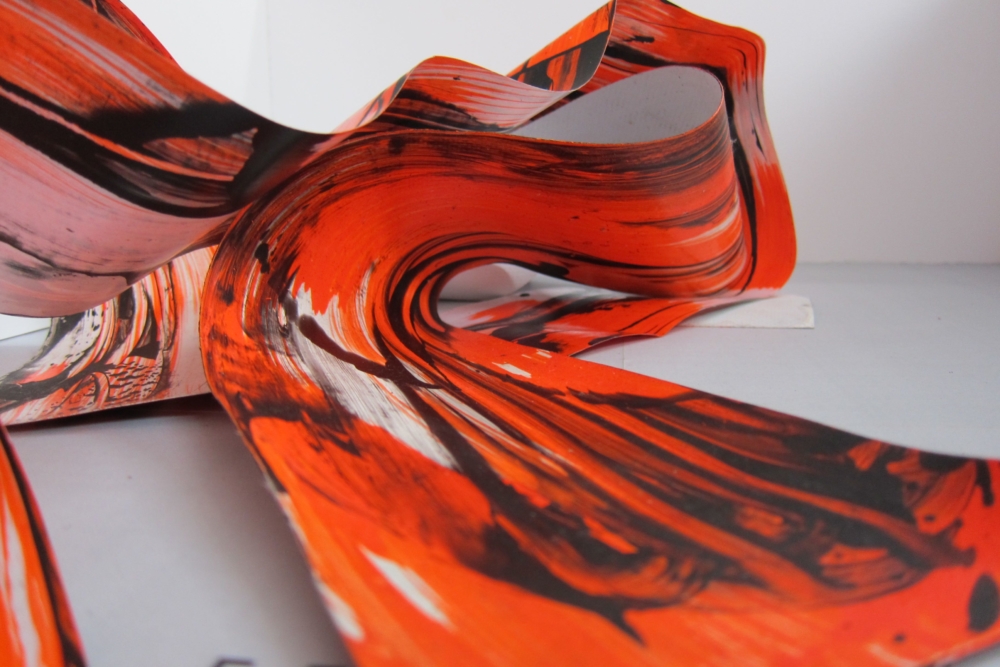
Robert Leonard talks to Judy Millar. The interview discusses her work in Personal Structures, Venice, 2010.
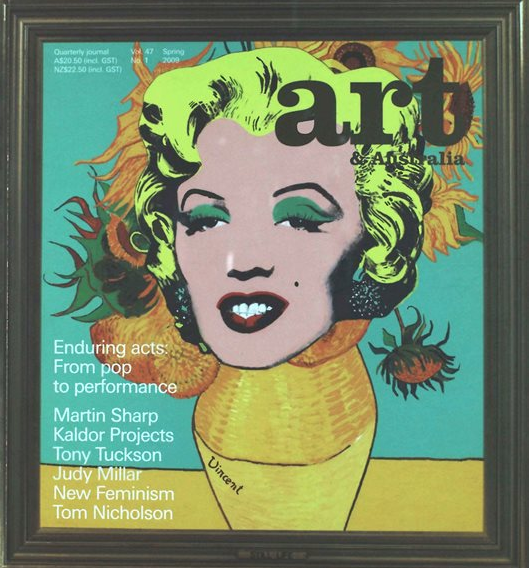
Essay by Morgan Thomas for Art and Australia. Vol 47. Spring. 2009.
Judy Millar’s solo exhibition at the Institute of Modern Art (IMA) Brisbane.
8th June – 27th July 2013.
Every time I make a painting I’m dragging the whole history of painting with me. — Judy Millar
Judy Millar: Be Do Be Do Be Do
Auckland painter Judy Millar has been making ever bigger paintings. A few years back, she surprised and confounded her audience by enlarging her painterly gestures using a billboard printer—it seemed heretical. Was this painting proper or something else? In Be Do Be Do Be Do, she goes the other way, hand-painting monstrously enlarged half-tone dots on ribbons of bendy-ply, which are contorted into complex curves, creating a play between the Arp-like biomorphism of the painted imagery and the Serra-like architecture of the scrolling wood. One curly painting, sitting on its edge, barricades a gallery; one, mounted to the wall, is all fleshly folds and love handles; another hangs from the ceiling from a harness, unfurling, flaccid, across the floor, revealing its pink underside. Rosemary Hawker reads Millar’s project through Susan Stewart’s interest in the play between the miniature (the world within the world) and the gigantic (the world without world).
Rosemary Hawker publication by IMA Brisbane, Australia. Available here.
5th February – 1st March 2014.
The second solo exhibition of Judys work in the gallery. The title drawing attention to the role of colour in Millar’s work; hot, strong, joyful, fiery, wild colour.
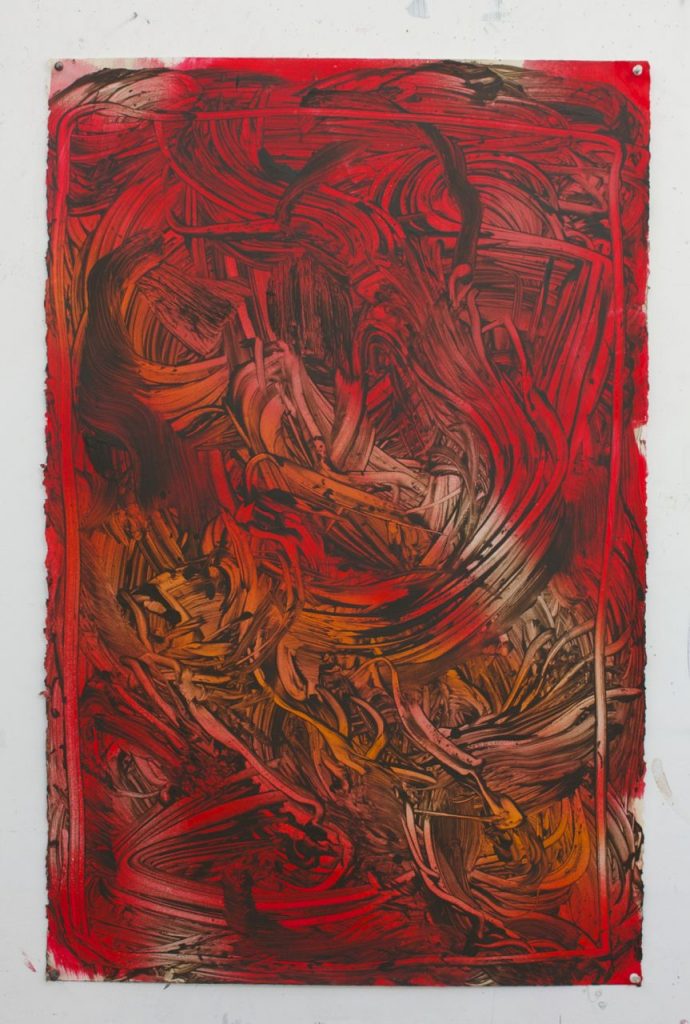
Much has been written about the Millar gesture – its bold, expansive, assured form swirling across her chosen surface whether canvas, paper or vinyl or, as we have seen most notably in her Venice Biennale exhibitions in 2009 and 2011, taking painting off the wall and into sculptural form out into space and the world. However here in this exhibition of three large and one smaller painting, paint remains contained and the place of colour in her work is foregrounded.
It is this colour that we respond to emotionally or sensually in the first instance before the intellect steps up and engages, drawing us in to Millar’s underlying project – a sustained investigation of the issues and challenges of painting and its place today’s visual economy today.
Rather than the issues of representation and the tension between two and three-dimensional space that have more often been discussed in relation to Millar’s work, what first comes to mind here are ideas about how painting engages with the emotions.
Again history provides the springboard with Kandinsky and his colour theories and Rothko and the colour field painters of the mid 20th century providing the starting point to let us think both about how art makes us feel personally and how it operates in a way that is quite different to its antecedents.
Formal purity is not a concern of this 21st century abstraction, what is more relevant is a kind of subversive questioning of possibility and progress.
Published by Kerber Verlag, Germany 2012
This Collector´s Edition consists of 80 exemplars, each one comprising an original work (acrylic on paper, 29.7 x 41.7 cm) by the artist and a fanfold publication, The Rainbow Loop.
Judy Millar’s works are distinguished by an intensive exploration of informal painting and Abstract Expressionism. The edition of original works is the result of individual, rolling processes that question interior and exterior, beginning and end. Each work of art is unique.
Available for Purchase.


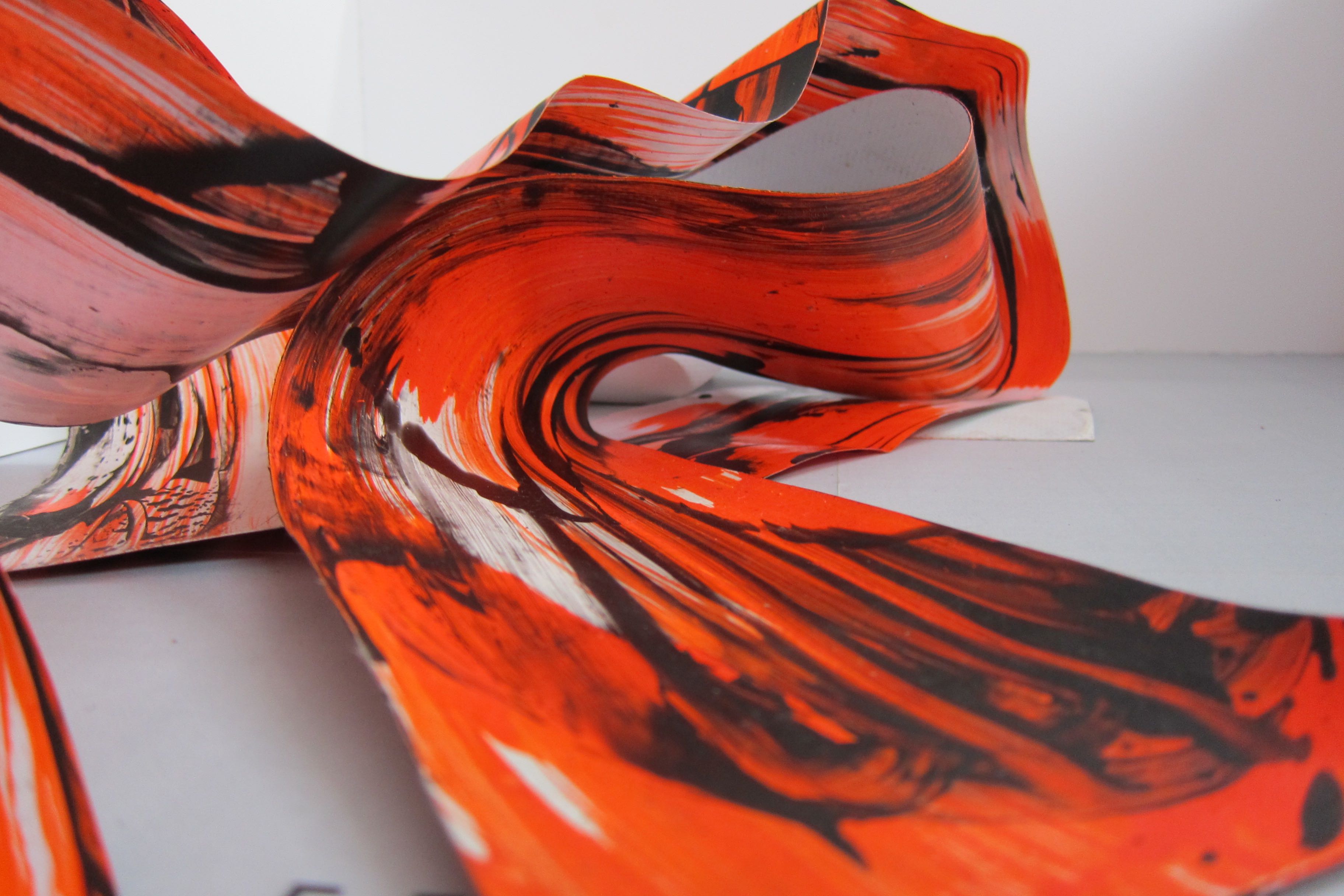
Judy Millar: For this exhibition, I’ve been given a small room with two beautiful windows, which open out onto a canal. I’m making a twosided painting that forms a big springy strip. The room is about 6m long but the painting is 20m long. Since the painting is too big for the space, there’ll be a tussle. The painting will be forced to lift itself up into the air, go out of the window, and come back in. It’ll double back on itself and loop around. It’ll be delicate but cumbersome, a physical gesture in real space but also a bearer of illusionistic painterly space.
Robert Leonard: You’ve been blowing up “the brushstroke” for a while now.
JM: It started with Giraffe-Bottle-Gun, my 2009 Venice Biennale show. I made small paintings, then enlarged the imagery to ten times the size. I used a billboard printer—an advertising tool—to do it. I wanted the work to advertise itself. I wanted to amplify everything.
RL: But the new work is painted, right?
JM: The orange bits are painted but the black bits are printed. Both have been up-scaled, but to different degrees and in different ways. I’ve been developing big brushes with multiple heads so that I can make giant gestures. I’m trying to find a bigger dimension for myself.
RL: With the up-scaling and the use of printing, are you trying to denature or dehumanise the brushstroke?
JM: I’m not trying to dehumanise it, if anything I’m trying to rehuman ise it. I’m trying to give it more authority. Despite the absurd scale, you still read the work through your body.
RL: In this work, your painterly marks piggyback on a support that is itself akin to a painterly mark–a flourish.
JM: Exactly, it’s gesture in real space that carries other gestures on its surface. The illusionistic surface distorts your sense of the real physical form, and vice versa. By manipulating the support structure itself, I’m dismantling the usual image/support hierarchy.
RL: I’m reminded of the plastic toy-car track that I had as a child. I would bend it into curves and loops and send my cars careering down it. Your support will operate as a track for vision.
JM: The eye is forced to follow the track. I can control the eye; slow it down on the curves and speed it up on the flat. Space will turn into time, and time into space. What was behind will suddenly be in front, edges will become lines and lines will become edges— everything will be turned inside-out.
RL: Because they are so antithetical, I was reminded of Lynda Benglis’s paint pours from the late 1960s. She let paint fall from the can onto the floor, whereas your piece is perky, springy, alert. It isn’t paintdoing- what-comes-naturally.
JM: I’ve never been one of those materialists who think paint is more interesting in the can. For me, painting is not about paint, or even about paint on a support. For me, it is about structures: illusionistic structures, logical structures, worldly structures, all sorts of structures. I’m not interested in paint simply as a material.
RL: So why paint?
JM: I stay interested in painting: it’s a way of collapsing the separation of the mental and the bodily that I experience in so many other parts of life.
RL: So, you’re affirming rather than critiquing painting.
JM: I’m questioning and hopeful. I’m asking what can painting still say, and hopeful that it can still say something.
_
Robert Leonard is Director of the Institute of Modern Art, Brisbane.
New York, 2010
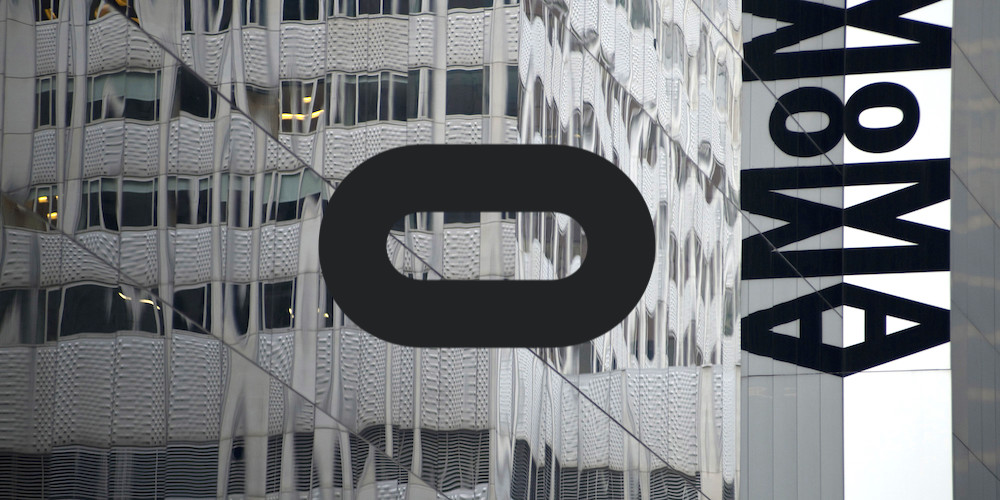
Image from uploadvr.com
Excerpt by Gemma Gracewood about a day spent with Judy.
Judy Millar’s MoMA artist’s pass is looking battered. “I’ve been at least twenty times since I got here,” she admits as we enter New York’s Museum of Modern Art. She pays for me – “I got my studio deposit back today. I feel rich.”
Judy is one of the more interesting characters on our art scene. Or, not on our art scene. She flies under the radar by living way out west of Auckland, yet she exhibits all over the world and keeps a studio in Berlin.
One of New Zealand’s foremost painters, Judy was one of our gals at the 2009 Venice Biennale. (For NZ folk, her Giraffe-Bottle-Gun work has been remounted at Te Papa for a spell.) I worked with her on the wonderfully bonkers TV series New Artland. In it, she guided a group of teenagers towards making an audaciously messy group painting, then turned into a giant billboard using a digital process similar to the one she went on to make her Venice work with.
1st May – 4th June 2010.
Written for Monopol Magazine, Germany
Für ihre raumgreifende Installation in La Maddalena benutzte Judy Millar riesige, mit stark vergrößerten Gesten der Künstlerin bedruckte Leinwände, die sich durch den Raum wanden und sich in ihm entfalteten; das Betrachten wurde für den Besucher zu einem kinematografischen Erlebnis, da das vollständige Erfassen der Installation nur durch das Umrunden der Leinwände, also durch Integrieren der Elemente Zeit und Bewegung, möglich war.
Für die aktuelle Ausstellung nimmt sich Judy Millar einer ‘white cube’ Galerie an; einem Raum, der völlig anders ist als eine barocke Kirche, der aber genauso mit malerischer Vergangenheit aufgeladen ist, und der sich genauso stark verwandelt durch ihre gewagte Installation.
Lange Leinwand-Bahnen, bedruckt mit Millars malerischen Zeichen, fließen durch den Raum der Galerie wie kollabierte Plakatwände, sie liegen gestapelt aufeinander, winden und rollen sich über sich selbst. Millars Gesten, auf der Leinwand zehnfach vergrößert, enthüllen einige wichtige, intime Details ihrer Arbeitsweise, aber sie haben auch einen grafischen, Comic-artigen, gar komischen Charakter. Sie werden zu eigenständigen Objekten mit einem Eigenleben, abgetrennt von der Künstlerin, die sie erschaffen hat. Wie Jennifer Gross schreibt: ‘durch das Vergrößern und Reproduzieren der manuellen Geste, wird der tatsächliche Malprozess der Künstlerin herauskristallisiert und übertragen.’ Gross beschreibt die bedruckten Leinwände weiter als ‘großräumige Nachwirkungen der Atelierarbeit.’
Das folgende Zitat von Judy Millar sagt viel über ihre Herangehensweise aus: ‘Als ich gestern mit dem Taxi durch die Stadt fuhr sah ich ein Bild, das sehr gut mit der Arbeit, die ich für die Ausstellung gemacht habe, korrespondiert. Eine Shampoo Werbung auf einem mehrstöckigen Hochhaus zeigte Haare, die in Locken die Fassade herunter und um die Ecke des Gebäudes fielen. Die Locken erhielten Volumen und Kontur durch die Form des Gebäudes und lösten gleichzeitig dessen Umrisse auf. Auf die gleiche Art und Weise transportieren die langen, Bänder-artigen Bahnen in der Ausstellung die übertriebenen malerischen Gesten, heben sie in und durch den Raum, während sie gleichzeitig durch die auf die Oberfläche gedruckten Bilder deformiert werden. Weitere Verzerrungen entstehen dadurch, dass der Betrachter das Bild nie von einer einzigen frontalen Perspektive erfassen kann, sondern sich entlang der Arbeit bewegen und sie in der Bewegung rekonstruieren muss.‘
Es ist diese Interaktion zwischen den malerischen Spuren der Künstlerin selbst – und deren Vergrößerung – und den realen Dingen der Welt – einschließlich der Betrachter – die Millars Arbeit jenseits eines vereinfachenden Diskurses über Malerei und Installationskunst ansiedelt. Stattdessen überschreitet sie die Linie zwischen bildlicher Fiktion, bildlicher Realität und realen Dingen im Raum. Durch diese Praxis beschäftigt sie sich mit einem fundamentalen Thema, das weit über Abstraktion hinweg bis in die Renaissance zurückreicht – namentlich in die Diskussion über die paradoxe Beziehung, die die Malerei mit der Welt hat, die sie einerseits versucht abzubilden und von der sie andererseits ein Teil sein will.
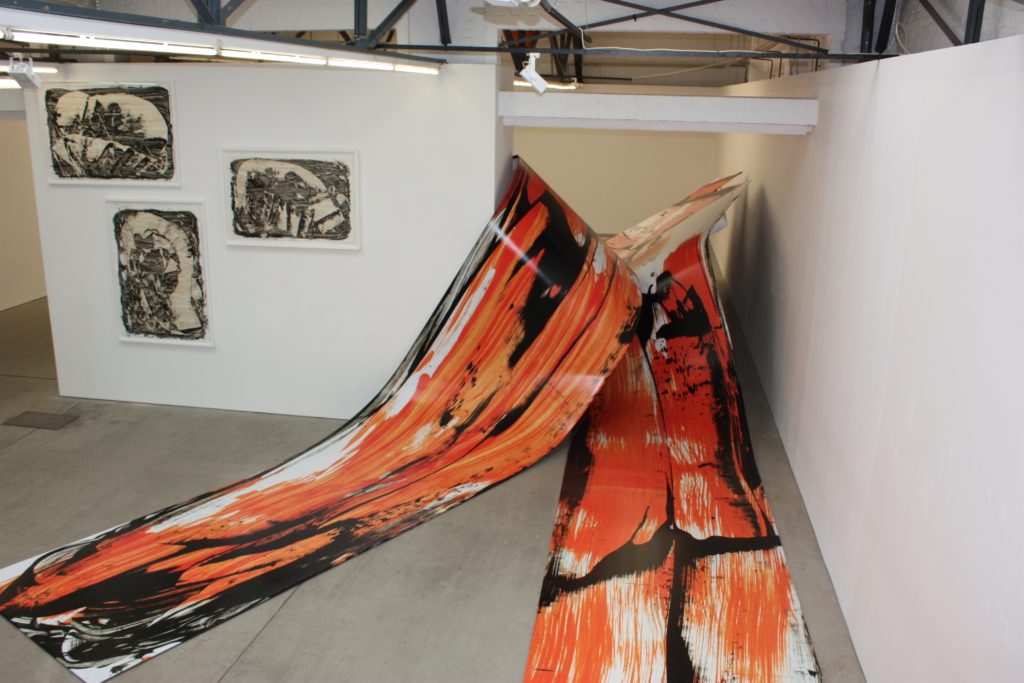
Millars Installation ist deshalb nicht nur ein Objekt, das wir schweigsam betrachten sollen. Fordernd, spielerisch und manchmal ganz und gar konfrontativ, zerrt und schubst sie uns durch den Raum und eröffnet uns Möglichkeiten neuer Entdeckungen und Erfahrungen. Dadurch birgt sie das Versprechen auf ein ‘besseres Leben’ in sich; einen Optimismus im Hinblick auf die Art und Weise, wie wir die Welt um uns herum erfahren, und die wichtige und menschliche Rolle, die die Kunst in dieser Welt spielt.
Judy Millar lebt und arbeitet in Berlin und Auckland. Sie nimmt gerade an einem dreimonatigen Atelierstipendium des ISCP in New York teil. 2009 vertrat sie Neuseeland auf der Venedig Biennale. Folgende Einzelausstellungen fanden in jüngster Zeit statt: Matte Black in der Galerie Mark Müller, Zürich; Butter for the Fish bei Gow Langsford, Auckland und The Secret Life of Paint in der Dunedin Public Art Gallery.
Judy Millar war 1994 Moet & Chandon Stipendiatin in Frankreich, 2002 gewann sie den Wallace Art Award. 2006 erhielt sie das Colin McCahon Atelierstipendium, das in jenem Jahr zum ersten Mal verliehen wurde. Weitere Stipendien erhielt sie von der Dunedin Public Art Gallery sowie dem Goethe Institut, Berlin. Eine umfassend Monographie über ihre Arbeit mit dem Titel You You, Me Me, erschien 2009 im Kerber Verlag.”
(Pressetext: Hamish Morrison Galerie)
Read originalartikel.Große Leinwandbahnen, die mit Millars malerischen Zeichen bedruckt sind, fließen durch die Galerie.
Spring – 2009.
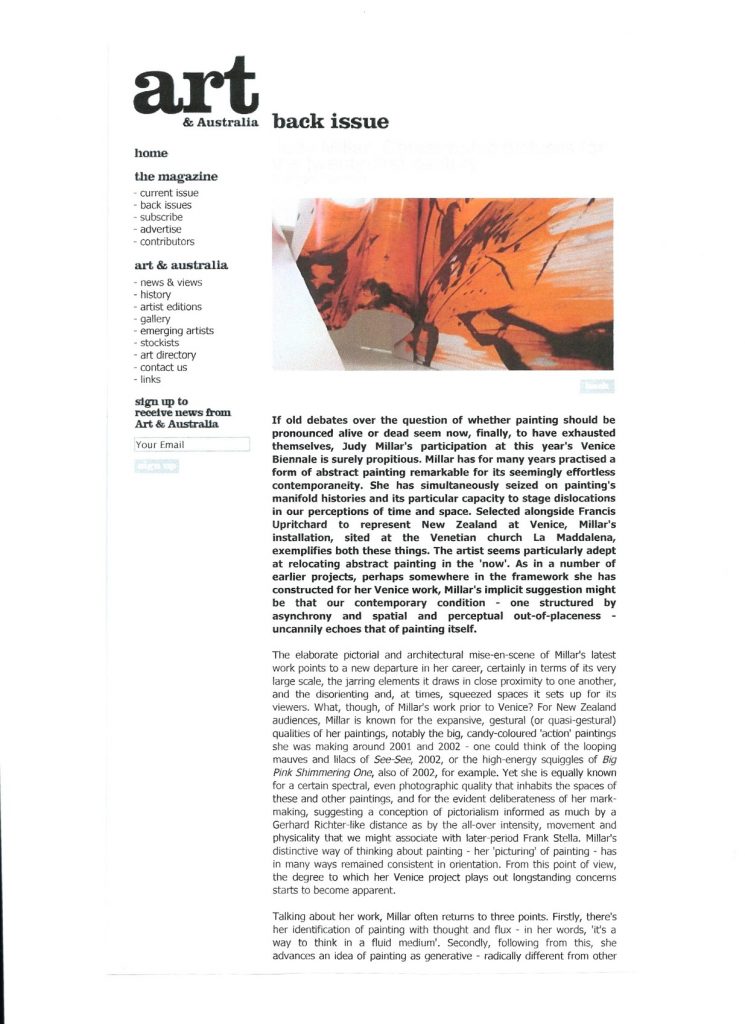
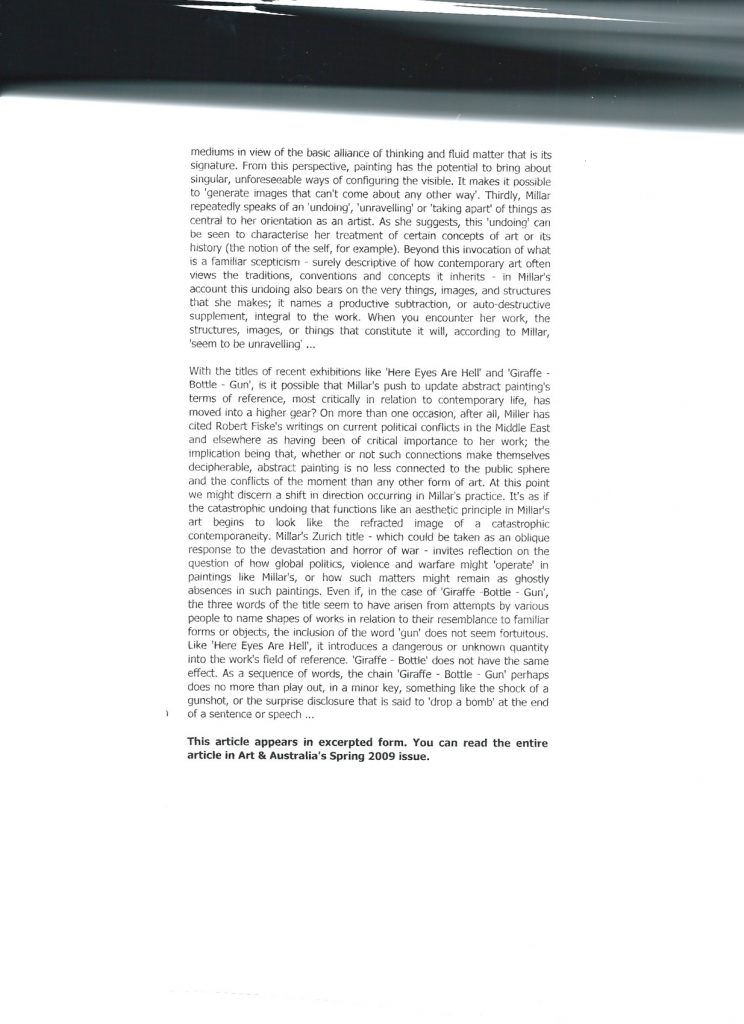 By Morgan Thomas.
By Morgan Thomas.
Publication Archive.